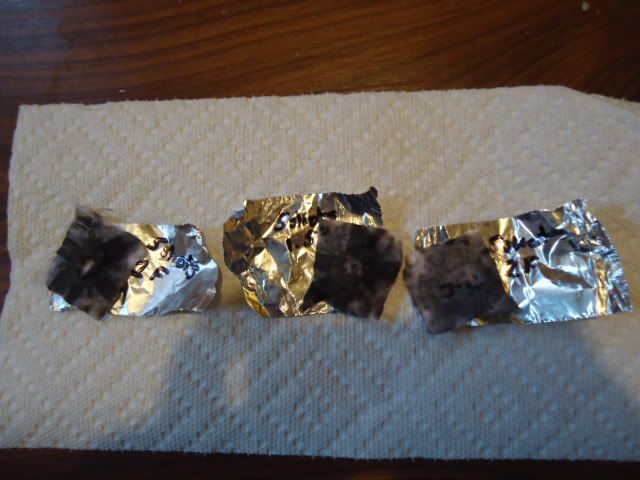Another test of the 2010 KIK
* At the range, after a 5 shot string of 45-70 reloads with no patching or blow tubing, ran a patch down the bore with a patch that was previously weighed. Wrapped each Fg - 1.5Fg and FFg patch in aluminum foil and took them home.
Purpose:
* To determine the dried weight of the foul as a percentage of the original charge ... is potassium bicarbonate and any unburned charcoal
* To look at the patches to observe the size of any charcoal that was not expelled with the ignition gas.
... Small finely ground charcoal= good stuff, better ignition
... Large pieces of charcoal = inferior grinding and impedes good ignition. In some powders, remain nameless to protect the guilty, I have seen charcoal in the foul that looked like 'logs'
Dried Patch % and Charcoal ObservationFg3.4gr/72gr of original charge = 4.72%
Charcoal = 'fine dust' and more than 1.5Fg or FFg
1.5Fg3.5gr/70gr of original charge = 5.0%
Charcoal = 'fine dust' and less than FFg but more than Fg
FFg2.4gr/68gr of original charge = 2.4%
Charcoal = 'fine dust' and least amount of the 3 grades
Wet Patches Picture Dried Patches in Oven @ 250F
Dried Patches in Oven @ 250F
Notice that the FFg (far right)wet patch looks 'cleaner' that the Fg (far left) or the 1.5Fg (middle)
Conclusion:
1. Due to the grain size ratios, the FFg powder burns cleaner than the other 2 grades
2. The majority of the charcoal is expelled with the ignition gas, being of fine micron size indicating that it is combusted upon ignition
3. Looks like FFg is the better grade than the other two: less bicarbonate and unburned charcoal.